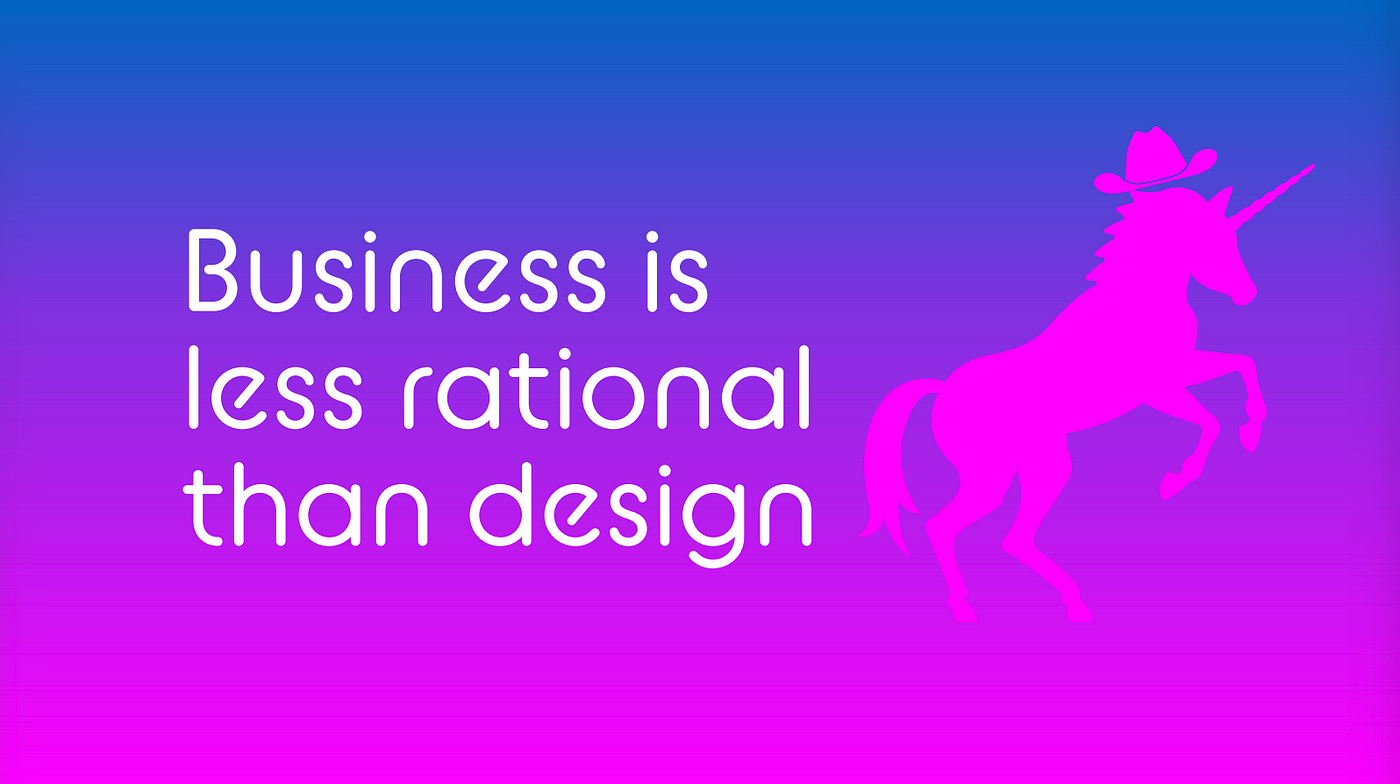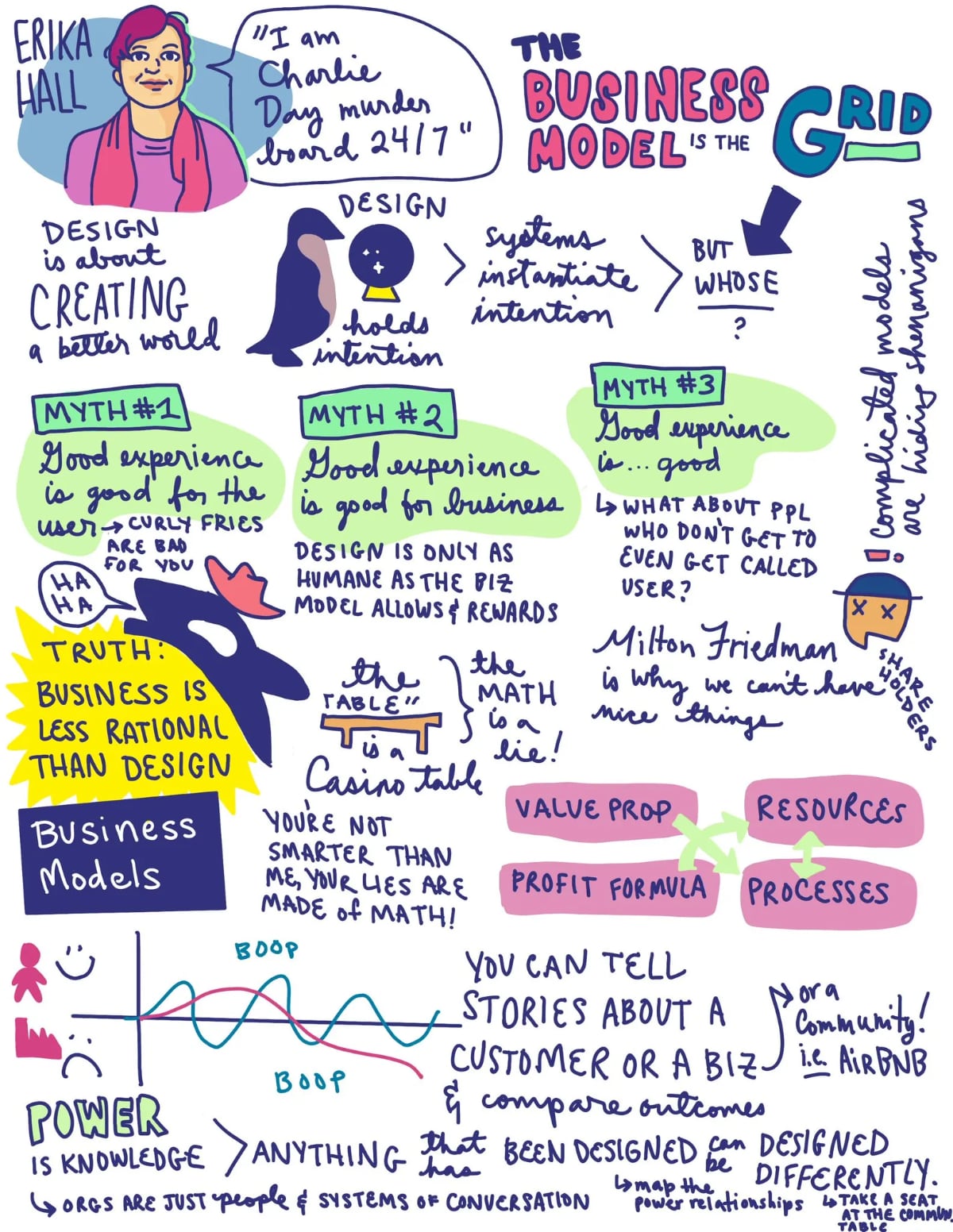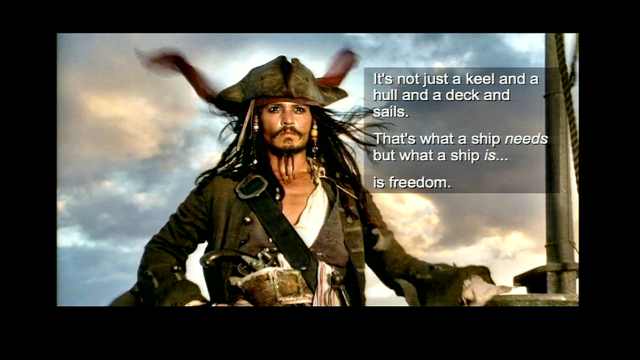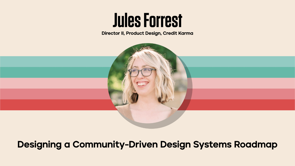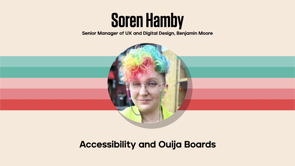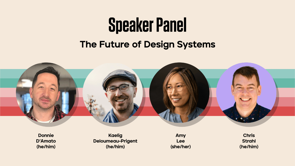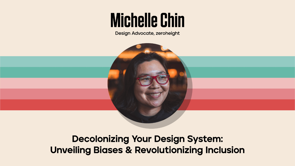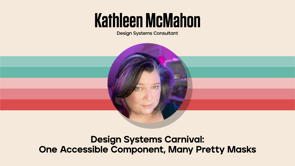The Business Model is the Grid
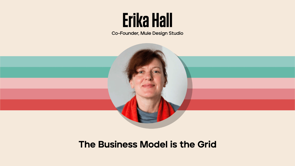
Introduction
Nathan Curtis introduces Erika Hall, co-founder of Mule Design and author of 'Conversational Design' and 'Just Enough Research', as she begins her talk.
Erika Hall's Opening Remarks
Erika Hall shares her excitement about presenting in her hometown movie theater and mentions her upcoming book related to the talk's topic.
Designers and Grids
Erika discusses the deep interest designers have in grids and her intention to delve deeper into this topic, leading to unexpected conclusions.
Influence of Khoi Vinh's Book
She references Khoi Vinh's book on grids for web design, highlighting the influence it had on her thoughts about design beyond just grids and systems.
Managing Uncertainty in Design
Erika talks about managing various levels of uncertainty in design, from craft to speculative territory, emphasizing the importance of process.
Design as an Optimistic Process
She describes design as an optimistic process, focusing on future intentions and making design systems resilient for users.
Design's Intention and Purpose
Erika urges designers to consider whose intentions they are serving and the purposes behind their work, affecting future world scenarios.
Three Myths in Design Practice
She addresses three myths embedded in design practice: the impact of user experience on users and businesses, and the overall goodness of a design experience.
Business and Design
Erika asserts that business is less rational than design and emphasizes the importance of storytelling, relationships, and power in business.
Management Theories as Self-Fulfilling Prophecies
Discussion on how management theories can become self-fulfilling prophecies, influencing business models and the role of design.
Business Bets on Human Behavior
Erika talks about businesses placing bets on human behavior and the significance of qualitative data in revealing truths.
Mapping Business and User Value
She suggests mapping business and user value against each other to evaluate sustainable business practices and ethical considerations.
Power and Organizations
Erika emphasizes understanding and influencing power relationships within organizations to advocate for ethical and sustainable design practices.
Q&A with Nathan Curtis
A Q&A session where Erika Hall addresses topics related to outcomes in design, the impact of business and design decisions, and the power of conversations in shaping design practices.
Nathan Curtis: It is really my distinct pleasure and honor to introduce Erica Hall.
Erica Hall is the co founder of Mule Design, is also the author of Conversational Design and Just Enough Research, both from A Book Apart, and without further ado, Erica Hall.
Erika Hall: Thank you, Nathan.
Hello, everyone.
This is so exciting for me.
This is my hometown movie theater.
This is where I saw Barbenheimers.
I'm like, I am Barbenheimer, Right.
So, this is all fantastic new material.
Thank you so much.
I'm working on a book on this topic now.
So this is my energy.
heh, this is always my energy.
I am Charlie Day Murderboard 47.
Woo!
Yeah, come a come along on this journey with me.
the journey of seeing how far my remote works.
Yes, grids.
heh.
so I was thinking about this because, designers are really deeply into grids, and I was thinking, I want to take you all a little deeper than we've been going, we're going to end in a weird spot.
so Khoi Vinh in his book about grids for web design, that came out about 10 years ago, he really said the quiet part loud in his book.
And I think a lot of people get into design, uh, not for bad tyranny, but because it, is really exciting to look at disorder.
And, take and exert control over that and order it and, make it nice for people because when you're designing, you're making choices on behalf of other people.
And, and I thought about this.
And, another way to think about design is that it's really a way to imagine a better world.
It's not just about grids.
It's not just about the systems on the surface.
But, it's taking that intention and moving it into the real world.
To continuously create new value for people and, imbuing systems with meaning and being methodical about that.
And the thing, about working in design is we're always managing levels of uncertainty, right?
If you're in the realm of craft and there's so many arguments about Oh, is what we're doing really craft?
And you can really see that as, working at the lowest level of uncertainty.
you pretty much know how it's going to turn out, but you can work all the way over on the other side, and be wildly into speculative territory.
And so the process is known, uh, the outcome is unknown and the plan is always subject to change, but it's always about having a process.
And so design is really an optimistic process because we are holding our intention for the future.
And the great thing about design systems is you're instantiating that intention and making sure, uh, everything will hold for a while and really making it resilient for people.
And, you're, but you're really thinking like, what do I want the world to be like?
But one of the things that I wish designers would, would think about a lot more is whose intention, and for what purpose are, we doing this work?
Because that really determines what the world of the future is going to be like.
and so I've been looking around and seeing basically the state of how things are right now and thinking like, there are so many designers and our tools are so good.
Why are things a mess right now?
What happened that we've all been working in design and a lot of our systems are falling apart.
And I think this is because there are three myths that have been embedded into our practice as designers.
the first of these is that a good experience is good for the user.
And we talk a lot about delight, and I think, the most delightful experience I can think of is curly fries, right?
When I think what's in the realm of food, what's a good experience?
Curly fries are the best possible experience of food.
But, just because I'm having a good subjective experience doesn't really mean it's super good for me and the tools and devices we have now, especially like smartphones, I bike to work and I just see people walking down, staring at their phones and those phones are so easy to use and so compelling to use and the apps that we're using on those phones are so convenient, but a lot of times they abstract us away from the deeper reality and our, the business models underneath that, the way they're using our data, the way that the systems are intervening in our personal lives, that's hidden from us.
And that's part of that good experience.
The second myth is that a good experience is good for business.
We hear this all the time, do the right thing for the user because it will benefit the business, but this is not necessarily the case.
have you used Google search lately?
Yeah.
Their business is going great, but things aren't so awesome.
And you look, just one example, it's always fun to talk about flying, if anybody had to fly here, choosing an airline ticket now is horrible.
And one of the reasons for this, right?
You try to pick a seat and it won't even let you pick a seat and every little thing is an add on.
Yeah.
do you want to board the plane ever?
That's an add on.
Something like that.
And the reason for this, do you want to even know what airline you're flying?
The reason for this is because we can now directly book flights ourselves.
We don't use travel agents.
And for this reason, people choose flights based on lowest base price.
So the whole experience, all the choices presented to us are to make that base price as small as possible.
And so that experience, that convenient experience, changed the relationship between the, app and the business.
And it's not great.
And you can, once you start looking for this, you can see it all over.
Design is only as humane.
And the business model allows and rewards.
That's the limit around that.
And once you start looking for this and saying, like, why are these experiences the way they are?
You'll start to see that a lot of times there's a misalignment.
And the third myth is that a good experience is good.
there was a lot of discussion in about, in the industry, among designers about Oh, should we be calling people users or should we be calling people humans?
And is it okay to call people users?
And the real issue are the people that don't even rise to the level of being called a user.
Think of all of the people who are affected by the system we're designing.
That the, organizations creating those apps and systems don't even contemplate.
And, I'm, that talk this morning about, decolonization and design is really important to think about because so many of the companies that are focused on the so called user experience are making things more convenient for the most privileged people.
And so we can't judge the effects of the work we're doing just based on, is it a really good user experience?
You have to ask for who?
And design can help, a useful ethical business be more successful, but it can also help extract value.
And exploit people and do all of these bad things while looking really great on the surface.
So this is three lies and a truth.
so the one true thing about business that I would like everybody working in design and technology to understand is that business is less rational than design.
There's this idea.
This sensibility around design.
There's a thing that maybe business people will say dismissively about people working in design, Oh, subjective, creative, whatever.
But the actual truth is that design is a, rational methodical process, right?
It's all about the process.
Business is about relationships and power and storytelling.
And I think because so much of these stories are expressed in numbers that, designers go into these conversations like, Oh, I've got to sell doing the right thing.
And because there's this background concept that Oh, but I'm the designer and I'm, bringing my empathy and my feelings and caring into business.
And business is this rational process.
right?
Like we heard yesterday, the truth is in the memes.
Think about what the memes about designers are about.
It's people wearing glasses, like looking super smart in front of whiteboards.
Business is all this.
Yeah.
No, it's true.
And so you go in and so all these designers go into these business conversations with all of the, business case and the ROI and the metrics.
Cause that's what business wants you to think it operates on.
Untrue.
All business.
And the last one is, placing bets on human behavior.
This is from a really fantastic article about using qualitative data.
Qualitative data will show you the true truth a lot faster than quantitative data.
But it's harder to manipulate, right?
Cause you're like, wow, I saw this person do a thing and they said a thing.
And that's the true truth.
And you can do a lot of lying with the math.
And so when designers talk about having a seat at the table, I don't think they realize it's a casino table.
Because the people operating these businesses think about the human beings as, essentially poker chips, really, whether it's employees or people out in the world.
And this is the mindset.
And so well meaning designers go into these conversations and they think Oh, if I just bring my smarts and my rationality and they're like, Oh, everybody's Woohoo.
Yeah.
Ha Business.
The math is a lie, like there's a lot of truth in folk stories, folk tales, and especially the Emperor's New Clothes.
Isn't it wild, this is all keynote shapes, this is all stock stuff, but you put underpants on that man and he looks more naked.
Or that person, that non gender specific person.
Graphic design is so powerful.
A lot of the math is made up, but, if you go into these conversations like, oh, that person has math, that person wants math, it's all, it's a lie.
anyone who says that they make decisions based on data and not stories is a liar, because we're human beings, and human beings work on stories.
Value is constructed out of stories, and sometimes we can measure things that are real in the world, but just because something is expressed in math doesn't make it more true.
Milton Friedman.
This will be the wackiest talk ever involving, Milton Friedman, basically the, the advocate of neoliberalism.
So he came up with the idea of maximizing shareholder value.
And this is like everything.
And so this story about what we should value more than anything else has completely infected business culture, and so why we can't have nice things, Milton Friedman is why we can't have nice things, 100%.
Yeah, and so much of this stuff is just stories, like supply side economics and Reaganomics was based on one dude at a dinner drawing a curve on a napkin.
True.
so this is, my hero, Symantra Ghoshal from the London, Business School.
He wrote this banger, if you like banger business school papers, Nathan probably does, bad management theories are destroying good management practices.
he wrote this paper, this was the last thing he did before he died, and it was about Enron, um, and if you're, it was, I can't explain Enron, if you don't remember Enron, and now I'm going to explain Enron, it was like Sam Bankman's Freed's deal, but in Texas and with oil futures and stuff, he said, why, don't we actually acknowledge in our theories that companies survive and prosper, when they pay attention to the interests of the customers and the employees and the shareholders and maybe even the communities, this was a rhetorical question.
He's like, why don't they do this thing?
Why is it just shareholders?
And he said, the honest answer is because this perspective cannot be mathematically modeled.
This is 100 percent true.
Like why are all these companies making record profits and laying people off when design is supposed to be creating all this value?
It's because the economics that underlies the business models is based on this notion that Oh, if our formula is just based on what's easy to put in the calculus and it doesn't even contemplate all of these other sources of value, then that makes our jobs as economists easier.
Real people are suffering so that economists have nice mathematical models and publish papers and get Nobel prizes.
100 percent true.
I love this guy.
And, Dan Coyle said that whether it's when expectations matter ideas have the power to shape reality.
This is the difference between social sciences and physics.
Economics wants to be physics, and so they come up with these models, and then the models can come true, and they change how people manage businesses, and they change the possibilities that we can envision as designers.
Management theories become self fulfilling prophecies.
Here's another fun fact.
Robert K.
Merton, the guy who invented focus groups, who also popularized the term self fulfilling prophecy, his son, Robert C.
Merton, came up with a mathematical model that enabled pricing of options and basically invented hedge funds.
Oh, and Robert K.
Merton was his magician name.
It's wild.
Just start reading stuff.
It's cool.
Like that, that blew my mind right there because I already talked about him because of the focus groups thing.
And I'm like, and he was a magician.
And then his son took the same name and invented this wacky math that like took down the economy.
Cool.
So my message here to all of you as designers is don't go into these business conversations thinking you don't have all the knowledge and all the facts.
You're going in a weird world.
So now I'm going to talk about business models.
here's a placemat, the business model, menu thing.
now it's a business model canvas, and this is really popular, and I don't think it's particularly useful.
it's good for knowing that you have something from every food group, but it doesn't tell you how those things are related.
It's true.
I want you to walk out of this and be able to go in, in any meeting with any CEO and just picture this and be like, you're not smarter than me.
You just, your lies are made of math.
any business is an exchange of value.
an exchange of value is, an interaction over time.
So this is all economies and business.
It's all just interaction design.
And so Clayton Christensen, I apologize for all the dead white Harvard guys in my talk.
he's the guy who came up with, disruptive innovation and jobs to be done, and also said some smart stuff about business models.
And what he said, remember when I said that design is a lot more rational than business?
he did this two year study of, businesses and business models.
And he was like, huh, it's weird.
Managers just do these businesses and they never actually think through the business model.
They just try stuff that he agreed about the whole casino thing.
And, and he did this study and he found patterns.
I know all of you like patterns.
He found patterns in business models and he said, here are the components of the model.
It's all these interactive elements.
And over time, these relationships become more and more solidified.
but each business model has a value proposition and resources and a profit formula and processes.
And they all interact in these different ways.
And I understand this is a slide crime.
I'm sorry.
they interact in these ways over time.
And this is essentially a maturity model.
And so the reason I'm showing this to you is because a lot of times, designers have this idea of design adds the same value at every point, and there's like a design maturity model, all this stuff, but it depends on what the, what matters to the model at different times.
And, and so the way he put it, the way, cause he like.
He likes, he was really hyped on his jobs to be done thing.
And he called the value proposition.
He's that's the, job of the, nevermind.
but if you, think about where you're currently working, you can think are we in the point of creating the business?
And that's when the business is just like throwing money to ah, we have a, value prop.
We have a value prop.
So we're basically going to be subsidizing things that make it really great for the users and the customers and all that.
Or are you in this kind of middle place where, okay, you're actually making money.
And so you want to cultivate those cult, those customer relationships, or are you back at this efficiency place where, and this is where when interest rates went up, a lot of businesses got here really suddenly.
Yeah.
all of a sudden, shed everything that matters because going back to the story about all we care about is maximizing shareholder value.
There are Hollywood studios who are like taking shows and just putting them in a vault for tax purposes.
All this stuff's going on just to have a better story to tell all the stock market, it's bad.
And, and so a lot of, A lot of money has gone into things, like how Uber for a long time was just subsidizing rides below the cost.
There's a lot of this going on, and I think because of the overall economic conditions of the last, 15 years or so, a lot of people got started in design careers and thought, oh yeah, business really cares about experience, business cares about design.
And no, it was just like getting people hooked.
And now the bill is coming due.
And this is because this is not a necessary condition.
This is because of the way these businesses were constructed.
And so the thing that Clayton Christensen was really right about is people start businesses just by placing bets.
They don't really think through, how do we create a business that makes money doing the right thing?
This is possible, but it's been really easy to just grow businesses.
And subsidize great experiences until the competition has been eliminated and everybody's hooked by network effects.
And now here we are.
This ends happy, I promise.
This isn't the only way, but for this not to be the way, we as designers, who care about things like human beings and accessible systems and ethics.
We have to get our hands dirty in the businesses themselves in order to make better businesses and organizations.
Because if we just do our work in the context of these businesses, this is where we end up.
So really quickly, there's a very simple tool to visualize like how your business is adding value or extracting value, so value is a story.
And we're used to customer stories and our customer or user stories, the journey map, right?
Yeah.
I hate the term touch point.
It's weird.
So I get like every interaction between a customer user and a business, let's just go boop, Right?
That's better.
I like that better.
And and our customer there, the customer's just trying to have a drink of water.
but the business is please engage with the business.
That's always the feeling.
I'm just trying to get a drink of free water.
Why are you trying to engage with me to generate shareholder value?
So you can draw out this story and, and create this narrative and say, okay, this is where we're delivering more value or less value to the customer.
And this is a really conventional graph.
And you can do the same thing with businesses.
Paul Graham, this is a useful thing he did.
He's the bad Y Combinator guy who said he only wants to fund people who wear hoodies and look like Mark Zuckerberg.
but he said, here's how startup stories go, right?
There are all these, places where it's like, Oh, you're doing really well.
Oh, you kind of crash.
And then you have a liquidity event.
where you either IPO or get an acquirer or otherwise, cash out and then happily ever after.
Yay.
So that's like a startup story.
But what happens is you take one of these companies that follows this traditional model of taking investment and after the happily ever after, you're in the public market or whatever and you're trying to grow and trying to grow and then, oh no, the, you've hit your wall of growth.
Because you didn't have a sustainable business model because you were care, you were worried about short term shareholder growth stuff.
And so the way a lot of businesses handle this, they hit that point and then they're like, ah, innovation.
And the way a lot of businesses do the innovation is by acquiring somebody like Figma [audience laughs and applauds].
spicy, we're getting spicy and talking about Milton Friedman.
Ah, so the nice thing is that with this very simple line graph, because whenever, I want you, whenever you see really complicated mathematical models to explain what business a business is in, that's hiding some shenanigans.
So what you can do is you can take the story of the human in the world just trying to get a drink of water.
And you can take the story of the business and you can map them against each other to see Hey, does making the human prosper?
Does that make the business prosper?
How are those related?
This is such a simple technique that anybody can do on any piece of paper, whiteboard, mirror board, whatever.
No one does this.
Why do businesses never talk about user and customer value and business value on the same chart?
Because they'd have to face some really ugly facts . It's so simple and, you can say, Hey, here's what happens if we're just handing money to people to make them happy over time, becomes really unsustainable for the business.
That's not good.
The reason why thinking about business is important is because you want to have nice things that are sustainable.
There's nothing wrong with running a profitable business.
There's something wrong if what you're doing is using the business to just extract value from humanity and the planet and all that stuff.
And you can also say, okay, this is very uncool, because what we're doing is making a lot of money and we're a ticket master or something.
see, oh, we make a lot of money when we just charge people fees for nothing.
Yay!
Try this with any business, really, it works.
And the good part about a chart like this, and the part that I think more of us should be doing more and more, is not just thinking about the business and the customer or the user, but thinking, who are all of the other stakeholders?
And what happens to them?
What happens to the people who aren't users, right?
The people who did not give permission for an interaction with this organization.
say the people who live in a neighborhood where there are a lot of Airbnbs and no homes for rent and mapping all of those people together over time to say, is this a sustainable situation?
So using a really simple graphical technique like this, can be very, powerful for understanding what the opportunities and limitations of interactive system design are and what the ramifications are, and including other people, because, don't on behalf of somebody else, actually talk to them and say, when this happens, is your wellbeing, better or, worse.
And the last thing I'll talk about is power because, uh, power is a relationship among people in an organization.
And if you want to go in and fight for good things and good design and sustainable systems, you're going to be going into power relationships.
So Conway's Law, uh, you might be familiar with Mel Conway, software engineer.
Articulated this like in the seventies or something like that.
Any organization that designs a system will produce a design whose structure is a copy of the organization's communication structure.
And what this means is that to put better systems, better design systems out in the world, you have to change the way the organization.
And this is possible.
so corporations, we talked about like we shape the tools and the tools shape us.
This isn't even like slander.
This is literally the definition of a corporation.
People can invest money and have no liability for what the corporation does.
But the nice thing about this is that anything that has been designed can be designed differently.
I don't want you to be down like, capitalism, because these are just, like tools and structures and artifacts that people have created to do a thing.
And you can go into them and say, how can we do those things differently?
And this requires going a little deeper, but that's the only way to get the things at the surface, that we want in terms of experiences and systems and all of that.
So a lot of times we think about the organizations we work with as these kind of static hierarchical structures.
But really organizations are relationships.
See I want you to think of the organi the big corporations you're working with, they're just people talking to each other, right?
It really is.
There can be so much fear and stress.
Like a lot of the consulting work I do is just literally getting people to talk to each other.
They're like, ah, these executives keep asking for the strangest things and then we've got to build them.
And I'm like, did you talk to them?
And Oh no, they're so powerful.
And it's just, a person.
They probably have a cat too.
Sorry, I didn't include a cat.
The cat's at home because this is an organization, that is now working from the, uh, little pipe structure.
They're working from the solid gold dancers set from the 80s.
I don't know.
and so if you know about systems theory, these, anything that's a conversation, the system of conversations is a series of feedback loops, and you can change those.
So if you change any individual conversation with a person in an organization, you change the organization and you're changed yourself.
And a lot of times we talk about feedback, especially in design, we talk about feedback.
And often when we're giving and receiving feedback, we're not really, we're reacting to things.
We're not thinking with intention, Oh, this is a system.
These people have power in the system.
How do I want to put input into that system to change it, to make it a more functional communication structure?
We don't think about that because you're always like, Oh my gosh, I'm in this terrifying power hierarchy.
So it, so you could just stop and reflect and think, okay, if I'm thinking of this system, this organization, not as this thing, but as this living interactive system with all these feedback loops, how can I put something into that to change how this system functions?
And you always have power to have different interactions with all these people in the organization.
Cause remember that it's just this, people, whenever you have a meeting, like think of this.
And so you can make a map of the power relationships, like who has power or status or influence or who, has a leadership role.
You can actually make a map just to understand, who has this power and where you should be applying your effort.
And that's another really useful, design deliverable.
It's, something, a power map is something people use in, social justice work, and that can be a really useful thing.
If you want to make your organization better, make your organization more ethical, start by thinking, who really has the power and influence to move things in the direction I want to move?
Everybody wants to innovate.
Nobody wants to change.
Human beings are human beings, and we've been like this for a long time.
in conclusion, uh, you do need a seat at the table, right?
But this table, the community table, outside these organizations, to have the kind of conversations that everybody here has been having.
About making things more ethical, and accessible, and sustainable.
And, I want to thank, a big shout out to Jina for inviting us to her table, right?
[audience applauds] Because this, these sorts of conversations, outside of those corporate structures, are where the seeds of that sort of change is planted, are planted, And this is the kind of work underneath the work that has to happen.
all of the design we're doing is contributing to the kind of future that we all want to inhabit together.
Nathan Curtis: White Harvard people, dead white Harvard guys, I think, something like that.
Yeah.
I need to correct you in a matter of disclosing who I am.
Erika Hall: Are you about to be a dead white Harvard person?
Nathan Curtis: You are so smart!
Milton Freeman went to the university, or was a Nobel Prize winner from the University of Chicago.
Erika Hall: Yes, Chicago School, yeah.
Nathan Curtis: My, graduate degree is in statistics.
I have a double major in math and statistics as an undergraduate, and I got my degree in a department that overlapped at the University of Chicago.
Erika Hall: Nice.
Oh, can we talk about Pinochet now?
Nathan Curtis: No, I actually don't know who Pinochet is.
I'm not gonna dig into that.
but I'm just gonna say, in some ways my education is part of the enemy.
Or the, or part of the like negativity of your talk.
And so I'm a little nervous.
and so I just want to relate that and talk about first math and statistics.
And where you use the term math a lot.
And that math is used to lie and people often say statistics.
There's, there's lies, damn lies, and then statistics is the worst thing.
And, math is really the pursuit of truth.
Provable truth.
And the statistics are the opposite of that.
They're the study of uncertainty, and you use uncertainty at the very beginning.
And so I'm curious, the first question is a softer opening question.
you talked about outcomes are really unknown, but can outcomes be predictable?
And are they almost predictable in a way that we should start to avoid them because they are predictable, and that's how you change.
Are outcomes really unknown?
Erika Hall: Define an outcome before I answer that.
Nathan Curtis: the outcomes of the design choices we make.
Can they really, are they really unknown to us at the beginning?
Or are we smart enough at this point to actually know, or at least be able to predict, what the outcomes are of the choices we make, or the things we choose not to do?
Erika Hall: I think that, that depends on the time frame, of course.
because, and it depends on the complexity of the factors, right?
The smaller number of factors and the shorter time frame, the more confidence you can have in a particular outcome coming to bear.
Nathan Curtis: Did you study statistics?
That's, a wonderfully simple way to talk about statistics.
if that's the case, I want to characterize how I think Design systems might be screwed.
And the reason is there are six things when we talk about measuring design systems success that are like categories of how we can think about it.
And there are three of them that roll off the tongue I believe first, when people say, why are we doing a design system?
We want to create more consistency.
We want to make things more efficient.
We want to improve quality.
And the only thing I see some teams measuring a bit, quality meaning usability, performance, accessibility, etc., is quality.
I see few, if any, design systems actually measuring the things they are primarily promising.
And instead, what design systems tend to measure are what did we produce, how much did they consume, And are they happy about it?
And is there a dissonance or a discord in the way that we as a community are measuring our own success?
Because those are the predictable things that we can measure.
What we make, whether they're using it, and whether they're happy about it.
And do we need to change our focus?
Because the other things, you can only really measure qualitatively, consistency and efficiency.
Erika Hall: I think that there is, too much of a focus on quantitative metrics because they give the illusion of certainty because of this, because of business culture, because I think often things are quantified not to understand, but to control, right?
So there's the saying like you have to be able to measure it to manage it, but I think often the people managing, don't have care for those things.
And they don't understand those things.
that's why NPS, you want to talk about statistics.
NPS was invented by a Bain consultant to give managers, a knob to twiddle, and managers who don't understand statistics.
And then it's been over applied to everything.
The guy who invented it came out and he's please, I'm so tired of surveys.
Because that was something in context, right?
All of this goes back to the designer's, response to everything.
We have to consider that in context and the outcome or the, the best path depends on the factors.
and that's a great example of a tool for quantification that made sense because it was designed for enterprise rent a car.
And, it made sense as a, as an indicator of how well the car rental experience was going.
And now, because it's being misapplied in this highly scalable context and because it's easy to like monof, monetize, survey instruments and quantitative analysis tools, much more than like, how do you monetize qualitative research?
Like a, pencil cannot get that expensive.
and so I think, there's a drive to quantify because like the, one of the big differences between, I'd say design culture and business culture is, the reason I had that slide is design is, based in uncertainty.
Like we're designing the future and we're, we know that we can't know everything, and we know things are going to be changing, and business comes along with the illusion of certainty, right?
That's business culture.
And, and so that's, I get asked all the time, like, how do we quantify research?
How do we quantify design?
And what you have to do is build relationships with the people you want to influence, so they trust you, and, then you won't have to make a case in terms that are purely symbolic.
yes, there are definitely things that you can measure that are meaningful, but quite often, the quantification is a power move and it's, and the, in, Sumantra Ghoshal's paper, he talks about the reason why economics wanted to be, it was so keen on being perceived as a physical science, as part of it is it lets you off the hook for ethical choices.
Nathan Curtis: Let's talk about that, because, there's a way that I feel like in the design systems, we're wonderfully living in a different place that's off the hook relative to all of our product designer counterparts.
We are essentially one degree separated from the product design decisions, providing a bunch of time that they hopefully all reuse.
And that insulates us from a lot of the day to day, challenges that, we don't have to answer calls at 2 a.
m.
on a release day because we're not part of that process most of the time.
but that also separates us from the decisions.
Does that actually make us not have to worry about it as much?
Are we abdicating our responsibility?
What can we do if we're that separated from some of those decisions as system designers of smaller user interface bits?
Erika Hall: the first most important choice is who to work for, right?
Because it's, I think, sometimes design as a Profession feels that oh, we have this hygienic barrier between us and the rest of the business.
We're the people who only do this one part of it, but I'd say anybody who works in design is as responsible as I'd say anybody else in the business.
So there's no like better part of a bad business to be in.
There's no, I'd say, changing things from the inside.
If you are in an organization that is structured to maximize shareholder value, right?
You have to understand, ultimately that's what it comes down to, and you can, I think the great thing about events like this and communities like this is you can increase the cost of not doing the right thing.
Because I think a lot of times designers like to talk about, oh, the benefits of doing the right thing.
And I think that's a losing argument sometimes because you'll get this nod and smile and okay, yeah, but we can't afford to do the right thing.
And we just laid off the right thing team, like, that's what, happens.
But if you go in and you're like, Hey, we're, we, have collective effort, we've unionized.
Oh, we all agree that, this is an ethical principle that we're going to talk about so much that we're going to create really bad PR for you.
If you don't do the right thing, if you don't make things accessible, if you increase the costs by working together and having that clarity and that heart and that compassion for people.
I'd say that's the way to get around, the quantification thing.
But you can't fight the quantification of everything mindset with quantification.
And I think that's what I try to talk to designers about.
Cause they're like, Oh, but we have to talk to business in business terms.
And it's business terms is good storytelling, right?
Business terms is why Adam Neumann is a billionaire while WeWork is going bankrupt.
It's sales.
And I know sales can be really uncomfortable for people, but that's how you get organizations to do the right thing.
Nathan Curtis: I don't know if you have an answer for this, but if you're familiar enough with the kinds of outputs and role that design system professionals play within larger scaled organizations, what kind of encouraging specific advice would you have for us, given what we produce, around what we can channel through, what we do, or what we can amplify.
Accessibility is an easy one, because that's where large corporations can feel significant single points of negative impact when they get sued, but is there anything other than touting accessibility that we can do, given the things we make.
Erika Hall: that is a really good question, but I'd say that the most important thing to do isn't, just in the technical work.
Like having really good technical work, because I think a lot of people, a lot of the, work and the, tools that go on, it is the most, like you are doing things that are useful for people that enable a lot of good things.
But I'd say it's, forming relationships with people throughout the organization.
Like you, I can't even tell you like how powerful it is to just have a conversation about the things that matter, like the things I've heard everybody here talk about for the last couple of days.
And just talking to somebody, listening first, listen to influence, and then model what it is to, be that kind of, of worker with those principles and those ethics.
And that's how you change organizations is, it's personal relationships one at a time.
It doesn't scale.
But it's demonstrating that kind of humanity that underpins the, technical systems that we've been talking about.
Nathan Curtis: When we started this conference, Jules gave a talk about roadmapping and the process she went through.
And she quantified the number of interviews or conversations she had, which was 42.
And to me, that was such an unexpectedly large number.
a lot of what you've contributed to our community is about conversations, it's about curiosity, it's about asking the right questions, and maybe about design more broadly, or design systems specifically, when you have conversations with designers to help them grow, get over the fear, and really, help them understand, like, how conversations lead to not just better success, but their own personal fulfillment and happiness.
Like, how do you put them on that path when you have conversations with individuals?
Erika Hall: I really, start by, one do you miss it?
Like the, anybody in power is just another person and that sort of thing, because there's so much fear in organizations at every level.
that's what I've seen.
I've been a design consultant for a long time and people are so afraid of talking to each other.
They're so afraid of being personally on the hook for a decision, which is also why the metrics are demanded.
and so the most important thing is to go into a situation with curiosity.
Don't worry, because so often designers and even researchers worry about going into these dynamics and having enough material, having enough expertise, having enough data.
And it's no, go in with questions.
Go in with genuine questions.
if you sit down with somebody, really try to understand that other human as another human.
And, and somebody who's been doing a really great job of this lately is Arnold Schwarzenegger.
Yeah, like he has a newsletter.
He has a new book out and he has been talking so much about continuously learning and being curious about people and being compassionate.
And now he's working on masculinity.
It's wild.
But so I'd say the most important thing I say to designers is, cause there's this fear of there's this constant, it's not even imposter syndrome.
It's just like fear of not having an answer at any given time.
and feel free, walk into a situation, this is always what we do at Mule, is walk into a situation and say, we have, we do not understand your business.
We don't understand you.
We are here to learn about you.
And if you flip your mindset from, I have to prove that I have enough expertise or enough data to be sitting down in this conversation, change that to, I'm going to set aside all my preconceived notions and I want to learn about you as a human being, you as a leader, a person in another discipline, I want to learn what your job is like.
Just ask people about what their day to day job is in your organization.
Just approach every situation with curiosity and it's so powerful.
You will learn so much and listening is such a gift to people.
And if you give other people the gift of your attention, they will give you the gift of their trust.
Nathan Curtis: I think that's where we end.
Please help me thank Erika Hall.
Erika Hall: Thank you.

